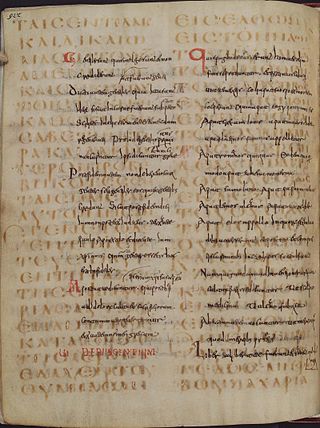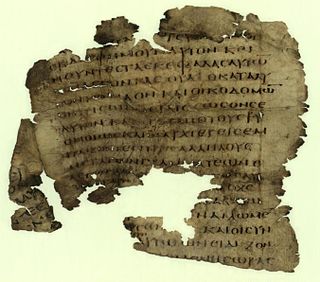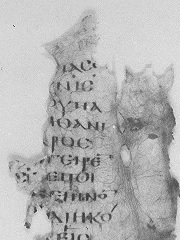
Codex Guelferbytanus A designated by Pe or 024, ε 33, is a Greek uncial manuscript of the Gospels, dated palaeographically to the 6th century. The manuscript is very lacunose.

Uncial 059, ε 09 (Soden), is a Greek uncial manuscript of the New Testament, dated paleographically to the 4th or 5th century.

Uncial 0175, is a Greek uncial manuscript of the New Testament, dated palaeographically to the 5th century The manuscript has survived in a very fragmentary condition.

Uncial 0176, is a Greek uncial manuscript of the New Testament, dated paleographically to the 4th century.

Uncial 0187, ε 024 (Soden), is a Greek uncial manuscript of the New Testament, dated paleographically to the 6th century.
Uncial 0214, is a Greek uncial manuscript of the New Testament, dated palaeographically to the 4th or 5th century.
Uncial 0216, is a Greek uncial manuscript of the New Testament, dated palaeographically to the 5th century.

Uncial 0217, is a Greek uncial manuscript of the New Testament, dated palaeographically to the 5th century.
Uncial 0219, is a Greek uncial manuscript of the New Testament, dated paleographically to the 4th century. The codex contains a small parts of the Epistle to the Romans, on 2 parchment leaves. It is written in two columns per page, 26 lines per page.

Uncial 0221, is a Greek uncial manuscript of the New Testament, dated palaeographically to the 4th century. The codex contains a small part of the Epistle to the Romans (5:16-17,19,21-6:3) on 2 parchment leaves. The text is written in two columns per page, 20 lines per page.
Uncial 0222, is a Greek uncial manuscript of the New Testament. The manuscript paleographically had been assigned to the 6th century. It contains a small parts of the First Epistle to the Corinthians (9:5-7,10,12-13), on 1 parchment leaf. It is written in two columns per page, 20 lines per page.
Uncial 0223, is a Greek uncial manuscript of the New Testament. The manuscript paleographically had been assigned to the 6th century. It contains a small parts of the Second Epistle to the Corinthians (1:17-2:2), on 1 parchment leaf. It is written in two columns per page, 17 lines per page.
Uncial 0226, is a Greek uncial manuscript of the New Testament. The manuscript paleographically had been assigned to the 5th century. It contains a small parts of the First Epistle to the Thessalonians (4:16-5:5), on one parchment leaf. It is written in two columns per page, 25 lines per page.

Uncial 0228, is a Greek uncial manuscript of the New Testament. The manuscript paleographically had been assigned to the 4th century. It contains a small parts of the Epistle to the Hebrews (12:19-21,23-25), on 1 parchment leaf. Written in one column per page, 17 lines per page.
Uncial 0229, is a Greek uncial manuscript of the New Testament. The manuscript paleographically has been assigned to the 8th century. It is a palimpsest.
Uncial 0231, is a Greek uncial manuscript of the New Testament. The manuscript palaeographically has been assigned to the 4th century.
Uncial 0236, is a Greek-Coptic uncial manuscript of the New Testament. Paleographically it has been assigned to the 5th century.

Uncial 0238, is a Greek-Coptic uncial manuscript of the New Testament. Paleographically it has been assigned to the 8th century.
Uncial 0240, is a Greek uncial manuscript of the New Testament. Palaeographically it has been assigned to the 5th century.
Lectionary 1386, designated by siglum ℓ1386 is a Greek manuscript of the New Testament, on parchment. Palaeographically it has been assigned to the 10th century. The manuscript has survived on only two leaves.









